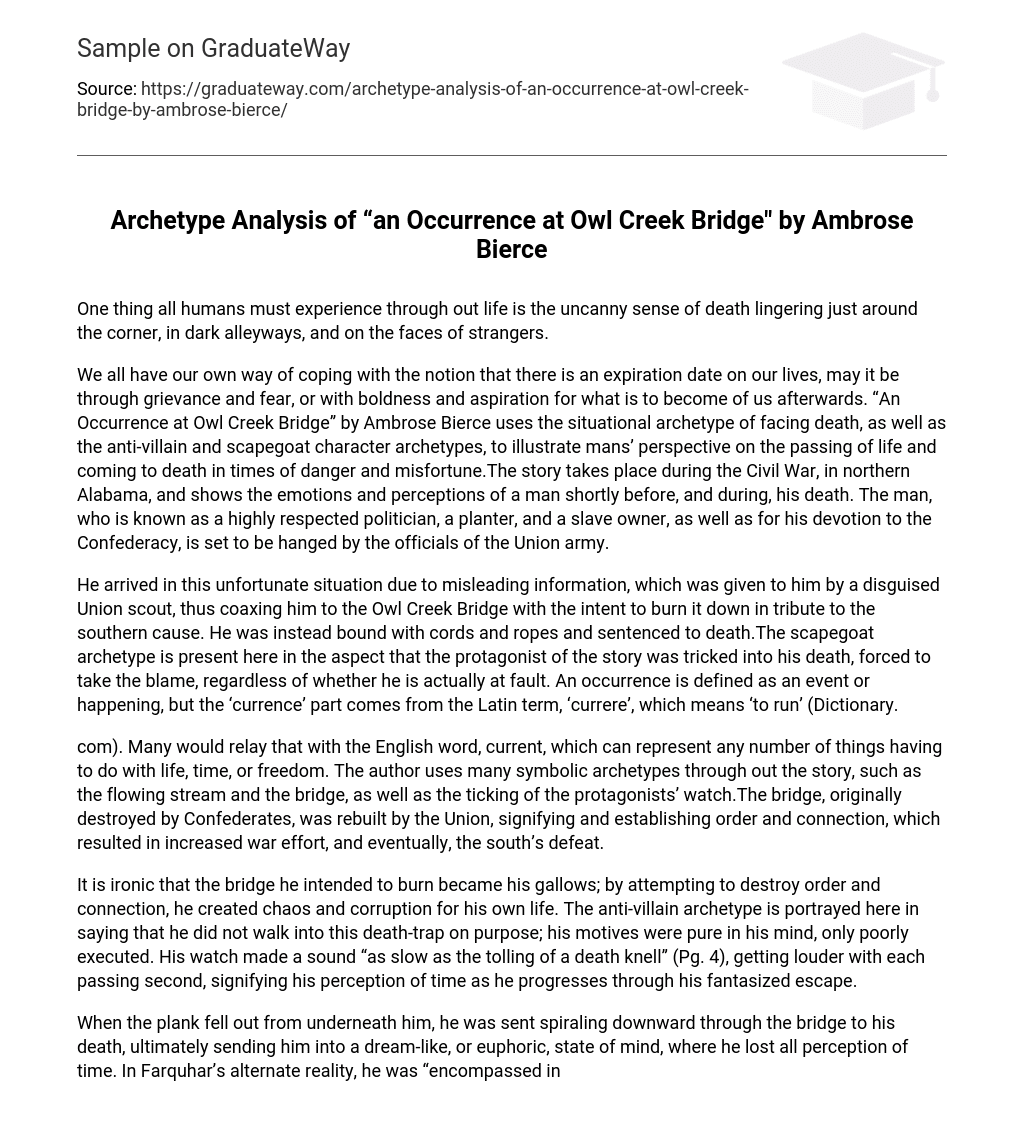One thing all humans must experience through out life is the uncanny sense of death lingering just around the corner, in dark alleyways, and on the faces of strangers.
We all have our own way of coping with the notion that there is an expiration date on our lives, may it be through grievance and fear, or with boldness and aspiration for what is to become of us afterwards. “An Occurrence at Owl Creek Bridge” by Ambrose Bierce uses the situational archetype of facing death, as well as the anti-villain and scapegoat character archetypes, to illustrate mans’ perspective on the passing of life and coming to death in times of danger and misfortune.The story takes place during the Civil War, in northern Alabama, and shows the emotions and perceptions of a man shortly before, and during, his death. The man, who is known as a highly respected politician, a planter, and a slave owner, as well as for his devotion to the Confederacy, is set to be hanged by the officials of the Union army.
He arrived in this unfortunate situation due to misleading information, which was given to him by a disguised Union scout, thus coaxing him to the Owl Creek Bridge with the intent to burn it down in tribute to the southern cause. He was instead bound with cords and ropes and sentenced to death.The scapegoat archetype is present here in the aspect that the protagonist of the story was tricked into his death, forced to take the blame, regardless of whether he is actually at fault. An occurrence is defined as an event or happening, but the ‘currence’ part comes from the Latin term, ‘currere’, which means ‘to run’ (Dictionary.
com). Many would relay that with the English word, current, which can represent any number of things having to do with life, time, or freedom. The author uses many symbolic archetypes through out the story, such as the flowing stream and the bridge, as well as the ticking of the protagonists’ watch.The bridge, originally destroyed by Confederates, was rebuilt by the Union, signifying and establishing order and connection, which resulted in increased war effort, and eventually, the south’s defeat.
It is ironic that the bridge he intended to burn became his gallows; by attempting to destroy order and connection, he created chaos and corruption for his own life. The anti-villain archetype is portrayed here in saying that he did not walk into this death-trap on purpose; his motives were pure in his mind, only poorly executed. His watch made a sound “as slow as the tolling of a death knell” (Pg. 4), getting louder with each passing second, signifying his perception of time as he progresses through his fantasized escape.
When the plank fell out from underneath him, he was sent spiraling downward through the bridge to his death, ultimately sending him into a dream-like, or euphoric, state of mind, where he lost all perception of time. In Farquhar’s alternate reality, he was “encompassed in a luminous cloud, of which he was merely the fiery heart, without material substance, he swung through unthinkable arcs of oscillation, like a vast pendulum. ” (Pg. 85).
This symbolizes him going through the stages of letting go of his physical being in order to be reinvented. As he recalls the senses of feeling and motion, and is able to form thoughts, we are led to believe the rope snapped and Farquhar was plunged into the stream below. His enemies pursued him with guns and the brass cannon atop of the bridge, but their efforts were no match for his enlightened senses. He was suddenly caught in a vortex and thrown upon the southern bank of the stream, hidden from his enemies.
“The baffled cannoneer had fired him a random farewell. ” (Pg. 7) So, he took that as initiative to plunge into the seemingly interminable forest, which signifies the “in-between”, or limbo, element of death. After traveling for days, with only the thoughts of his wife and children to keep him going, he fell asleep while walking.
When he awoke, he found his wife waiting and his home exactly as he left it, but “as he is about to clasp her he feels a stunning blow upon the back of his neck; a blinding white light blazes all around him with a sound like the shock of a cannon…his body, with a broken neck, swung gently from side to side beneath the timbers of the Owl Creek Bridge. (Pg. 88). Some might compare this scene to “the light at the end of the tunnel”, which could very well be an accurate description.
The cynical twist at the end of this story implies that Farquhar’s fantasy was played out in mere seconds, or rather, in the time it took for him to fall the length of the rope that was tied around his neck.This story mainly focuses on perception and interpretation, where as Farquhar’s fine lines between reality and fantasy are only distinguished by the sensory detail in the story. The passing of life and coming to death in the face of adversity is a matter we will all have to deal with at some point in life, whether it is you or a loved one going through these tough times, always be sure to think first, speak second, and act last, because your actions speak louder than your words ever will.





